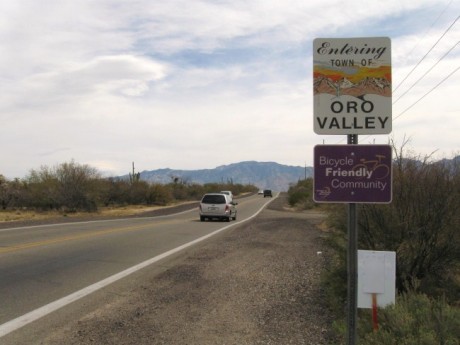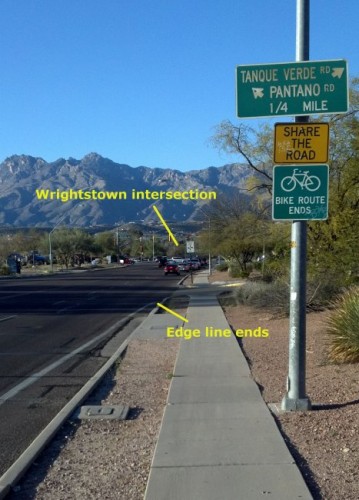Editor’s note: Freelance writer Scott Lunt spends his cycling time piecing together impromptu loop rides and running occasional errands. Soaking in the Tucson sun since 1994, he can be found two-wheeling around town on his Bacchetta Giro 20 recumbent.
So you’re riding on a road you’ve never cycled before. Lots of traffic is screaming by, but that’s okay because you’re in a nice bike lane. Oh happy day.
Then, a hundred yards after you just passed an intersection the bike lane starts narrowing until — poof — it ends like teenage first-love. Heartbroken, you suddenly feel much more intimate with the tons of metal and rubber that whizz impatiently past you.
This is what happens when you’re riding east on Tangerine Road, just as you pass the intersection at Thornydale Road. Or consider riding north on Pantano Road. Just before the intersection at Wrightstown Road, the edge line abruptly ends in front of an apartment complex. It seems as if you can feel the mass of northbound traffic shift to the right at that moment.


This may be no big deal if you’re an experienced road biker or grizzled touring veteran. But for someone who’s not used to riding in traffic, the sudden disappearance of their “savior lane” can be terrifying.
So why do perfectly good bike lanes suddenly end at the most inconvenient places? According to Tom Thivener, the bicycle and pedestrian program manager for the City of Tucson, reasons include:
- Lack of funding.
- The edge line is dropped to accommodate a turn lane or additional traffic lane.
- There is simply no room to put in a bike lane, or the road is too busy and constrained to remove existing lanes in order to add a bike lane.
Thivener said he is aware of the gap at Wrightstown and Pantano. “I can’t explain why it got striped the way it did,” he said, adding that “when funding is available we’ll look to shift the lines around so that we can put an edge line in for the bicyclists.”
And if there’s a case where it’s physically not possible to add a bike lane, Thivener said that just reinforces their efforts to put in good bike facilities on parallel streets.
So is there an overall plan to address these gaps?
According to Thivener, the Bicycle Advisory Committee has identified around 200 different areas where there are gaps in the bike lane system on major streets and “we’ve been chipping away at that,” he says noting they’ve completed dozens of miles in the past couple of years.
“Tucson suffers from a lack of funding to go and aggressively do these, but we’re still chipping away given the resources that we have,” he said. In fact, he notes, there are a few projects coming up this spring, all using Regional Transportation Authority funds, designed to complete bike lane gaps on the following roads:
- Ajo Way from Valley Road to I-10
- Valencia from the Santa Cruz River to 12th Avenue
- Alvernon Road from Paseo Grande to 29th Street
As far as that intimidating little stretch on Tangerine Road, the situation is a little more complicated. According to an e-mail I received from Pat Klein, the constituent services coordinator for the Town of Oro Valley, the three-mile section between Thornydale Road and La Canada Drive encompasses three jurisdictions, with 0.7 of a mile in the Town of Marana, 0.3 of a mile in Pima County and 2 miles in the Town of Oro Valley.
The three jurisdictions are working on a design, as part of a RTA plan, to widen Tangerine Road from I-10 to La Canada Drive. The design includes a four lane divided roadway with six-foot bike lanes, and will be completed in three phases:
- Phase 1 will be from La Canada Dr to Thornydale.
- Phase 2 will be from Thornydale to Prospect Wash.
- Phase 3 will be from Prospect Wash to I-10.
Depending on funding, Phase 1 is expected to start in Fiscal Year 2015/2016.
Although Tucson does have an impressive number of bike lanes compared most other cities, funding continues to be an issue so there’s still a chance that you’ll find yourself suddenly stranded between flashing side-view mirrors and the curb. So how do you avoid that?
Tucson metro bike maps are big help. And Thivener has more advice:
“Do your homework ahead of time. Get to know our streets. Get to know the route between your work, home, your shopping opportunities,” he said. He notes that there should be alternative routes available in the residential areas if you don’t feel comfortable on the main roads in the urban core.
He also recommends taking one of the bike safety courses offered by the city or county to help become a more confident rider.

Love the post. This is a painful chicken/egg dilemma many cities seem to be confronting now. Namely, it is tougher to increase ridership without infrastructure. It is tough to increase infrastructure funding without increased ridership.
Like you say, until that shakes out, cyclists have to be savvy. Along those lines, folks are doing some clever things to map the gaps.
Here’s London’s #cyclesafe map that allows any cyclists to submit dangerous points of the city for bikes:
http://www.thetimes.co.uk/tto/public/cyclesafety/contact/
This is so useful that every city should have one of these. Not only is it an essential tool for planners, it is also a dramatic illustration of the issue that politicians can use to justify funding.
Good article, Scott.
If all of a person’s cycling depends on a bike-lane or striped shoulder, then the usefulness of the bike is going to be significantly compromised.
Folks have to be competent and confident in their ability to ride the line or
take the lane when appropriate.
Take the county bike skills class or join a bike club, ask a friend or practice in an empty parking lot….anything except waiting for the government to make it nice for you. The personal benefits will be much greater and the infrastructure that much more appreciated when it does appear.
This seems to be such a stumbling block with ridership. This is not meant to be hard-assed-sounding and I know a lot of people have gone this route.
I guess there needs to be a blog for non-cyclists to get this message to.
I can appreciate the shortish span of Tangerine road wherein the bike lane disappears. On that section of road, I was actually brushed by the blade of an oversized bulldozer being towed on a tractor-trailor rig. Fortunately users in that area can bypass that section of Tangerine by taking Moore Rd.
An essential skill new riders (and some more experienced ones) need to learn is to find alternatives, as mentioned, to those uncomfortable sections of road. It’s not something that’s often mentioned to new riders, so this article serves that end perfectly.
Scott Lunt’s incisive and well-documented piece is valuable, as is Tom Thivener’s common sense advice: research your route; learn your route and alternatives — calm early weekend mornings are best for this. Then you graduate…
While a good article, the point is really moot. These stripped areas to the right of the fog line are not bike lanes, they are improved shoulder. In order for it to be a bike lane, it must be signed in black and white, have signage painted on the road, and there must be a local ordinance stating such. None of this is done in Tucson. So we are doing autos a favor by riding on the shoulder.
Why do new or inexperienced riders continue to insist on bicycles having to be on the shoulder since we are are not required by law to ride on the shoulder. Take the county bike education course and learn to take the lane when it is required for your safety and comfort.
Probably because they see cars and trucks driving closer to the outside line than the center line on a regular basis. At some point, self-preservation should kick-in.
What good is a sign in the end? Will a sign suddenly cause a careless driver to be a careful one? Or the ones that do it on purpose, will they have a change of heart because of a sign? Will they stop fumbling for what ever piece of crap they’ve got their attention on more than the road? No sign does any of this.
At any rate, what irks me is when (for example W Linda Vista tie in to the new Twin Peaks) a road is paved new from the dirt up and it’s not even wide enough to keep the stripe off the dirt shoulder in spots! You just paved this whole thing new and couldn’t drop a decent shoulder on it? FU.
Tucson needs intentionally designed bicycle routes. More cyclists are coming and many more would ride if they felt safer. The rate of return from providing safer routes for bicycle riding is greater then those for motor vehicles. Commuting cyclists shouldn’t need the bike handling skills of an experienced trials rider in order to get across town.
I’m with A Bicyclist. Killing someone on a bike doesn’t appeal to motorists’ sense of self-preservation either. (Paperwork, court/jail time, blood on fender). So they move left.
Back on topic, in midtown, there’s 60 feet of a phony bike lane on Highland just north of Sixth. It ends with an arrow pointing directly into an angled curb. Would love to hear the explanation for that piece of work.